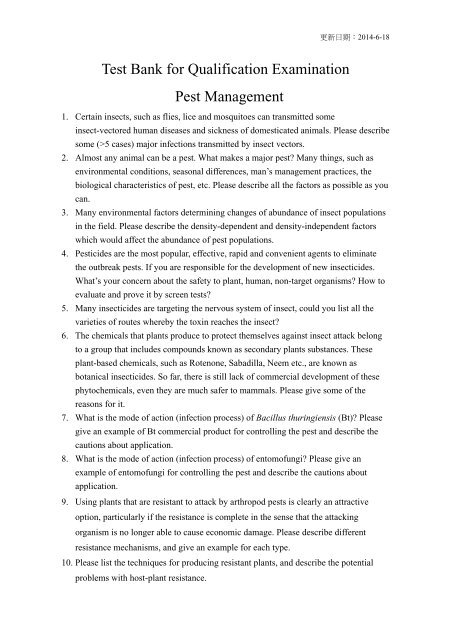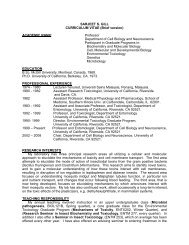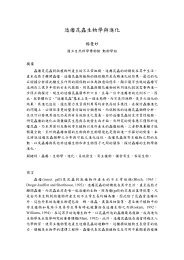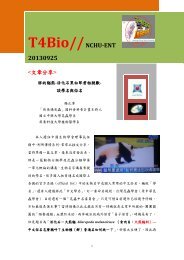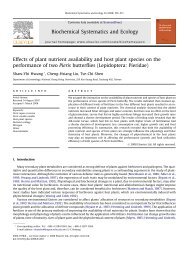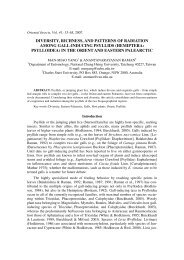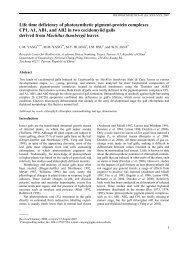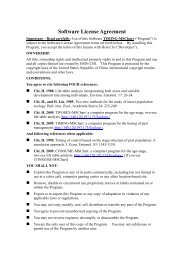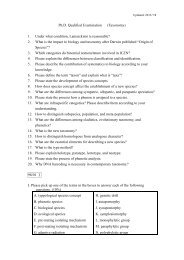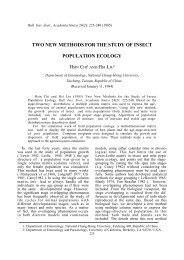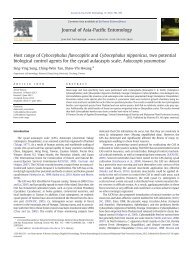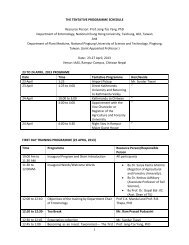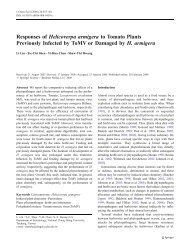é²æ²»(Pest Management)
é²æ²»(Pest Management)
é²æ²»(Pest Management)
Create successful ePaper yourself
Turn your PDF publications into a flip-book with our unique Google optimized e-Paper software.
更 新 日 期 :2014-6-18<br />
Test Bank for Qualification Examination<br />
<strong>Pest</strong> <strong>Management</strong><br />
1. Certain insects, such as flies, lice and mosquitoes can transmitted some<br />
insect-vectored human diseases and sickness of domesticated animals. Please describe<br />
some (>5 cases) major infections transmitted by insect vectors.<br />
2. Almost any animal can be a pest. What makes a major pest? Many things, such as<br />
environmental conditions, seasonal differences, man’s management practices, the<br />
biological characteristics of pest, etc. Please describe all the factors as possible as you<br />
can.<br />
3. Many environmental factors determining changes of abundance of insect populations<br />
in the field. Please describe the density-dependent and density-independent factors<br />
which would affect the abundance of pest populations.<br />
4. <strong>Pest</strong>icides are the most popular, effective, rapid and convenient agents to eliminate<br />
the outbreak pests. If you are responsible for the development of new insecticides.<br />
What’s your concern about the safety to plant, human, non-target organisms? How to<br />
evaluate and prove it by screen tests?<br />
5. Many insecticides are targeting the nervous system of insect, could you list all the<br />
varieties of routes whereby the toxin reaches the insect?<br />
6. The chemicals that plants produce to protect themselves against insect attack belong<br />
to a group that includes compounds known as secondary plants substances. These<br />
plant-based chemicals, such as Rotenone, Sabadilla, Neem etc., are known as<br />
botanical insecticides. So far, there is still lack of commercial development of these<br />
phytochemicals, even they are much safer to mammals. Please give some of the<br />
reasons for it.<br />
7. What is the mode of action (infection process) of Bacillus thuringiensis (Bt)? Please<br />
give an example of Bt commercial product for controlling the pest and describe the<br />
cautions about application.<br />
8. What is the mode of action (infection process) of entomofungi? Please give an<br />
example of entomofungi for controlling the pest and describe the cautions about<br />
application.<br />
9. Using plants that are resistant to attack by arthropod pests is clearly an attractive<br />
option, particularly if the resistance is complete in the sense that the attacking<br />
organism is no longer able to cause economic damage. Please describe different<br />
resistance mechanisms, and give an example for each type.<br />
10. Please list the techniques for producing resistant plants, and describe the potential<br />
problems with host-plant resistance.
更 新 日 期 :2014-6-18<br />
11. Please describe the methods of genetic manipulation, and give an successful case of<br />
controlling by SIRT (sterile insect release technique).<br />
12. What are biorational compounds? Please give an example regarding how to use the<br />
insect growth regulators to control pests.<br />
13. 試 詳 述 何 謂 Integrated <strong>Pest</strong> management ? 是 述 其 系 統 架 構 及 基 礎 ?IPM 的 施 行<br />
步 驟 為 何 ? 任 舉 一 例 說 明 其 施 行 方 法 ?<br />
14. 何 謂 economic injury level 及 economic threshold 如 何 利 用 前 面 兩 項 來 分 辨 害 蟲 的<br />
等 級 ?<br />
15. 何 謂 Cultural techniques? 目 前 有 哪 些 技 術 已 被 採 用 ? 並 舉 例 說 明 各 種 技 術 之 方<br />
法 及 所 防 治 之 害 蟲 對 象 ?<br />
16. 何 謂 IGR? 包 含 哪 幾 大 類 ? 對 害 蟲 之 作 用 機 制 為 何 ?Methoprene 在 使 用 上 有 哪<br />
些 缺 點 ?<br />
17. 試 述 蟲 生 真 菌 在 田 間 造 成 流 行 病 (epizootic) 之 過 程 ?<br />
18. 試 比 較 寄 生 性 及 捕 食 性 天 敵 在 生 態 學 及 應 用 上 有 何 不 同 ?<br />
19. 建 立 一 個 Classical biological control 計 畫 需 要 具 備 哪 些 步 驟 ?<br />
20. 試 依 培 養 、 時 效 及 操 作 特 性 等 觀 點 , 比 較 三 種 常 用 之 生 物 防 治 法 的 差 異 ?<br />
21. 試 比 較 寄 生 性 及 捕 食 性 天 敵 在 生 態 學 及 應 用 上 有 何 不 同 ?<br />
22. 試 述 蟲 生 真 菌 入 侵 昆 蟲 造 成 致 病 過 程 ? 試 說 明 蟲 生 真 菌 防 治 害 蟲 之 優 缺 點 ?<br />
23. 昆 蟲 之 所 以 成 為 害 蟲 其 可 能 的 因 素 有 哪 些 ?<br />
24. 試 述 Bacillus thuringiensis 及 其 產 物 對 昆 蟲 之 效 應 ? 如 何 應 用 此 資 材 於 害 蟲 防 治<br />
工 作 .<br />
25. 繪 圖 說 明 昆 蟲 病 原 性 病 毒 的 基 本 結 構 , 種 類 及 對 昆 蟲 的 感 染 機 制 ? 田 間 應 用 需 注<br />
意 事 項 .<br />
26. 詳 述 Type of resistance ? 及 所 包 含 的 機 制 ?<br />
27. 何 謂 Antibiosis? 該 植 物 本 身 具 有 哪 些 生 理 生 化 特 性 ? 對 昆 蟲 產 生 的 作 用 機 制 有<br />
哪 些 ?<br />
28. 利 用 農 耕 操 作 防 治 害 蟲 時 , 對 寄 主 作 物 及 做 環 境 可 進 行 哪 些 操 作 技 術 ?<br />
29. 如 果 你 是 菜 農 以 蔬 菜 為 例 , 如 何 規 劃 一 個 完 善 的 Organic farming system?<br />
30. 造 成 昆 蟲 對 寄 主 植 物 偏 好 成 度 的 機 制 可 能 有 哪 些 ?<br />
31. 利 用 抗 蟲 品 種 所 衍 生 哪 些 潛 在 問 題 ? 試 詳 述 之<br />
32. 何 謂 Cultural techniques? 目 前 有 哪 些 技 術 已 被 採 用 ? 並 舉 例 說 明 各 種 技 術 之 方<br />
法 及 所 防 治 之 害 蟲 對 象 ?
更 新 日 期 :2014-6-18<br />
99/01 Ⅰ<br />
1. What is the difference between the “Economic Threshold” and the “Economic Injury<br />
Level”? Please give an example to explain it.<br />
2. What is the mode of action (infection process) of nematode? Please give an example<br />
of nematode for controlling the pest and describe the cautions about application.<br />
3. Please describe the definition of “integrated pest management”, and give an example<br />
(any crop and pest) to list the processes and strategy (example).<br />
4. What is pheromone? Please describe their functions of various types. How to use<br />
pheromone in IPM?<br />
5. Cultural techniques comprise those that involve the manipulation of an<br />
agroecosystem in order to decrease the success of pest species within it. Please<br />
describe the relative techniques for improving plant health.<br />
99/01 Ⅱ<br />
1. Insects are the major vectors of arthropod-borne pathogens, such as Aphididae,<br />
Aleyrodidae, Psyllidae, Cicadellidae, Delphacidae and Cercopidae. Please describe<br />
the interactions between vector and plant pathogens.<br />
2. There are annual predictable migrations of many pests. These migrations can be over<br />
very large distances. Please describe the possible monitoring and controlling<br />
approaches we can do before those making big problems.<br />
3. The modes of action (MOA) of organochlorines, organophosphates, carbamates,<br />
synthetic pyrethroids, avermectins, nicotinoids, and insect growth regulators (IGRs)<br />
are different from each other. Please describe the superiorities and defects of them.<br />
4. What is the mode of action (infection process) of nuclearpolyhedrosis virus (NPV)?<br />
Please give an example of NPV for controlling the pest and describe the cautions<br />
about application.<br />
5. Since the first well-documented success with a biological control agent in 1888 to the<br />
present there have been more than 5000 different attempts at classical biological<br />
control. Please describe the methods of using biocontrol agents and give a schematic<br />
of a stepwise procedure for establishing a classical biological control programme.
更 新 日 期 :2014-6-18<br />
99/02 Ⅰ<br />
1. Explain “botanical insecticides” by using five chemicals as examples. Describe their<br />
toxicological mechanisms and list the target pests for each chemical.<br />
2. What is “physical control” of pests? Please illustrate their application in the fields.<br />
3. Describe all kinds of pheromone functions, and explain how to apply them in pest<br />
control.<br />
4. How to use “biotechnological methods” in transgenic plants in pest control system?<br />
5. What is the mode of action of entomopathogenic fungi infecting insect pest? How<br />
to apply entomopathogenic fungi in the fields for the pest control?<br />
99/02 Ⅱ<br />
1. Insects cause damages to plants in directly feeding or indirectly pathogen-vectoring<br />
way. There are lots of vectors responding for transmission of arthropod-borne<br />
pathogens. Please give an example to describe the interactions between vector and<br />
plant pathogens. In addition, list the possible control methods.<br />
2. Carbamates, nicotinoids, and insect growth regulators (IGRs) are different from each<br />
other. Please describe the modes of action (MOA) of them, and give an example to<br />
describe their superiorities and defects.<br />
3. What are the difference between the “Economic Threshold” and the “Economic<br />
Injury Level”? Please give an example to explain it, and describe the importance of<br />
ET in pest management.<br />
4. What is the insecticidal mode of action (infection process) of Bacillus thuringiensis?<br />
Please give an example of B. thuringiensis subsp. kurstaki, aizawai, and israelensis<br />
for controlling the pests and describe the cautions about application.<br />
100/01 Ⅰ<br />
1. In agroecosystem, some insects act as vectors of arthropod-borne pathogens, such as<br />
Aphididae, Aleyrodidae, Psyllidae, Cicadellidae, Delphacidae and Cercopidae.<br />
Please describe all the four patterns (mechanisms) of viral transmission by these<br />
vectors. By the way, take an example of pest management strategies against them.<br />
2. The modes of action (MOA) of organophosphates, synthetic pyrethroids, nicotinoids,<br />
and insect growth regulators (IGRs) are different from each other. Please list a table<br />
to give a common name of representative insecticide in each group, and describe<br />
their MOA.<br />
3. For an increased public perception of the dangers associated with synthetic<br />
insecticides, various entomopathogenic agents of biological control had been
更 新 日 期 :2014-6-18<br />
explored. Please list commercially available bacterial-, fungal-, viral-, and<br />
nematode-based formulations for arthropod control (including microbial agents, the<br />
processes of infection, and target pests respectively).<br />
4. The three ways in which biocontrol agents can be used, such as classical biological<br />
control, augmentation/inoculation, and habitat manipulation. 1). How to choose the<br />
most appropriate way for the pest control in different situations?<br />
2). Please give a<br />
schematic of a stepwise procedure for setting up a classical biological control<br />
programme.<br />
5. What is the definition of integrated pest management? Please give me a proposed<br />
model IPM system based around the use of transgenic corn (Bt-GMO).<br />
100/01Ⅱ<br />
1. What is insect sex pheromone? Discuss how it used in IPM (integrated pest<br />
management).<br />
2. Give examples to discuss the difference between “MAT (male annihilation<br />
technique)” and “SIT (sterile insect technique) and their application in IPM<br />
(integrated pest management).<br />
3. What is microbial control of insect pests? Discuss the mode of actions of their<br />
infection process.<br />
4. Give example to discuss how to use “physical control” in pest management in the<br />
fields.<br />
5. What is insect vector transmission of plant pathogen and discuss the interaction<br />
between vector insects and plant pathogens.
更 新 日 期 :2014-6-18<br />
100/02 Ⅰ<br />
* 第 1、2 題 各 15 分 , 第 3 題 20 分 , 除 文 字 外 亦 可 製 圖 、 表 應 答 。<br />
1. 利 用 生 物 技 術 研 發 抗 蟲 基 改 品 種 農 作 物 必 需 考 量 的 問 題 為 何 ? 另 請 敍 述 Bacillus<br />
thuringiensis -endotoxin expressing GM corn 對 天 敵 (predator and parasitoid) 可 能 造<br />
成 之 影 響 , 再 列 舉 如 何 降 低 該 等 負 面 衝 擊 之 措 施 。<br />
2. 請 就 偵 測 (detection/diagnosis)、 監 測 (monitoring/inspection)、 預 測<br />
(forecasting/projection)、 預 警 (early warning/alert for control timing) 等 層 面 探 討 目 前<br />
國 內 長 期 以 來 執 行 重 要 病 蟲 害 防 治 之 改 進 空 間 , 依 此 提 出 您 的 建 議 ( 可 用 東 方 果<br />
實 蠅 或 斜 紋 夜 蛾 為 例 , 此 二 種 害 蟲 已 耗 費 政 府 數 十 年 之 經 費 人 力 但 仍 難 以 掌<br />
控 , 亦 可 用 其 他 害 蟲 ~ 如 小 黑 蚊 , 薊 馬 , 褐 飛 蝨 …. 等 )。<br />
3. 台 灣 農 地 面 積 有 限 , 農 業 生 產 多 屬 小 農 制 , 為 提 高 生 產 量 農 民 經 常 依 賴 化 學 藥 劑<br />
的 使 用 , 而 造 成 殘 留 農 藥 違 反 國 家 食 品 衛 生 安 全 容 許 量 之 標 準 , 甚 至 在 施 藥 時 承<br />
受 中 毒 之 風 險 , 且 造 成 部 份 重 要 害 蟲 之 抗 藥 性 產 生 , 導 致 害 蟲 管 理 更 難 以 奏 效 。<br />
政 府 近 年 來 提 倡 『 植 物 醫 生 』 之 觀 念 , 並 有 少 部 份 鄉 鎮 巳 有 實 施 , 但 其 實 務 效 益<br />
有 限 。 試 寫 出 一 套 具 有 可 行 性 的 計 畫 來 改 善 目 前 農 藥 誤 用 或 濫 用 的 情 況 ( 包 含 教<br />
育 、 管 理 及 推 廣 輔 導 之 層 面 )。<br />
100/02Ⅱ<br />
一 、 何 謂 微 生 物 防 治 (microbial control)? 試 述 三 種 蟲 生 病 原 導 致 昆 蟲 感 病 的<br />
機 制 及 如 何 增 強 其 田 間 防 治 應 用 效 能 。(20%)<br />
二 、 物 理 防 治 (physical control) 包 含 那 些 防 治 技 術 及 如 何 應 用 於 害 蟲 綜 合 管<br />
理 。(10%)<br />
三 、 何 謂 性 費 洛 蒙 ? 試 舉 例 說 明 如 何 應 用 於 害 蟲 管 理 。(10%)<br />
四 、 何 謂 “classical biological control"? 防 治 應 用 時 需 考 慮 何 施 行 步 驟 。<br />
(10%)
更 新 日 期 :2014-6-18<br />
101/01 Ⅰ<br />
(Please choose 5 test questions from them)<br />
1.Insects are the majority vectors of arthropod-borne pathogens, such as<br />
Aphididae, Aleyrodidae, Psyllidae, Cicadellidae, Delphacidae and<br />
Cercopidae. Please describe the transmission pathway (mechanism) of<br />
plant pathogens by vectors. (please give one example for description)<br />
2.The modes of action (MOA) of organochlorines, organophosphates,<br />
synthetic pyrethroids, nicotinoids, and insect growth regulators (IGRs) are<br />
different from each other. Please describe the superiorities and defects of<br />
them.<br />
3.Please propose one Integrated <strong>Pest</strong> <strong>Management</strong> (IPM)-based Farming<br />
System for a citrus orchard. (you may give an example of any else crop)<br />
4.What is the mode of action (infection process) of nuclearpolyhedrosis<br />
virus (NPV)? Please give an example of NPV for controlling the pest and<br />
describe the cautions about application.<br />
5.Cultural techniques comprise those that involve the manipulation of an<br />
agroecosystem in order to decrease the success of pest species within it.<br />
Please describe the relative techniques for improving plant health.<br />
6.The three ways in which biocontrol agents can be used, such as classical<br />
biological control, augmentation/inoculation, and habitat manipulation. 1).<br />
How to choose the most appropriate way for the pest control in different<br />
situations? 2). Please give a schematic of a stepwise procedure for<br />
setting up a classical biological control program.<br />
101/01Ⅱ<br />
1. Explain the interactions between insect vectors, plant viruses and their<br />
hostplants on transmitting insect-borne plant diseases, and describe how to<br />
manage the disease transmission in the fields.(15%)<br />
2. Give an example to explain how to enhance microbial control effect in<br />
pest management in the fields.(10%)
更 新 日 期 :2014-6-18<br />
3.Describe “cultural control” and explain how this concept is applied in<br />
pest management in the fields?(10%)<br />
4.Define “classical biological control” and explain the procedures in pest<br />
control.(15%)<br />
102/02 Ⅰ<br />
1. 請 闡 述 蘇 力 菌 (Bacillus thuringiensis) 對 鱗 翅 目 害 蟲 之 致 病 機 制 ; 而 近<br />
十 年 來 國 際 上 利 用 Bacillus thuringiensis -endotoxin expressing 轉 殖<br />
玉 米 來 抗 玉 米 ; 螟 及 玉 米 穗 蟲 之 為 害 , 請 分 別 就 此 害 蟲 之 寄 生 蜂 與 捕<br />
食 性 天 敵 (parasitoid and predator) 可 能 造 成 之 影 響 探 討 GMO 在 生 態<br />
上 可 能 造 成 之 負 面 衝 擊 。(15 分 )<br />
2. 請 就 檢 疫 (quarantine) 、 偵 測 (detection/diagnosis) 、 監 測<br />
(monitoring/inspection) 、 預 測 (forecasting/projection) 、 預 警 (early<br />
warning/alert for control timing) 等 層 面 探 討 目 前 國 內 可 能 巳 入 侵 之 西<br />
方 花 薊 馬 (Frankliniella occidentalis) 之 檢 疫 漏 洞 , 並 列 舉 可 行 之 防 治<br />
措 施 。(15 分 )<br />
3. 台 灣 農 業 生 產 多 屬 小 農 制 , 為 提 高 生 產 量 農 民 經 常 依 賴 化 學 藥 劑 的<br />
使 用 , 但 常 因 農 民 誤 判 害 蟲 種 類 而 用 錯 藥 劑 , 或 者 頻 頻 增 加 用 藥 濃<br />
度 而 造 成 農 藥 殘 留 違 反 國 家 食 品 衛 生 安 全 容 許 量 之 標 準 , 甚 至 在 施<br />
藥 時 承 受 中 毒 之 風 險 , 且 造 成 部 份 重 要 害 蟲 之 抗 藥 性 產 生 , 導 致 害<br />
蟲 管 理 更 難 以 奏 效 。 假 設 您 是 農 委 會 防 檢 局 相 關 業 務 承 辦 人 員 , 為<br />
了 要 改 善 上 述 問 題 , 而 受 命 負 責 建 立 我 國 之 『 植 物 醫 生 』 制 度 。 試<br />
寫 出 一 套 具 有 可 行 性 的 推 行 計 畫 ( 從 學 校 到 農 場 ), 來 達 成 解 決 或 改<br />
善 目 前 農 藥 誤 用 或 濫 用 的 情 況 。(20 分 )
更 新 日 期 :2014-6-18<br />
102/02Ⅱ<br />
1. What is microbial control of insect pests? Please describe the mode of<br />
actions (infection process) of these microorganisms. (20%)<br />
2. What is cultural control of insect pests? Please describe their application<br />
in the fields. (10%)<br />
3. Define “classical biological control” and explain the procedures in pest<br />
control. (10%)<br />
4. Describe the definition of “ areawide pest management” , and give an<br />
example to explain the strategy. (10%)


